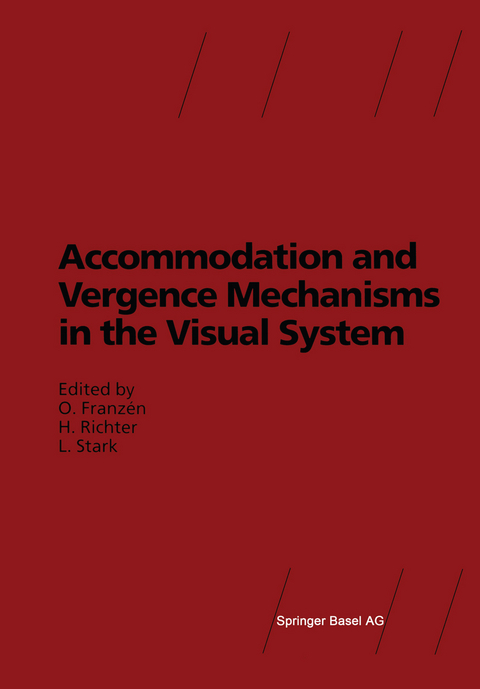
Accommodation and Vergence Mechanisms in the Visual System
Springer Basel (Verlag)
978-3-0348-7588-2 (ISBN)
I CNS pathways, single unit, neural population and structural correlates of the accommodative system.- Neuronal circuits for accommodation and vergence in the primate.- Neural codes for three-dimensional space.- Neuronal connectivity between the accommodative and active fixation systems.- The pupillary light reflex, accommodation and convergence: Comparative considerations.- Vergence eye movement and lens accommodation: Cortical processing and neuronal pathway.- Research on dynamic accommodation using TDO III (Three Dimensional Optometer III) and MEG (Magnetoencephalography).- Neuroanatomical correlates of the near response: Voluntary modulation of accommodation in the human visual system.- Functional neuroanatomy of the human near/far response of the visual system to blur cues: Fixation to point targets at different viewing distances.- Spatial contrast sensitivity and visual accommodation studied with VEP (Visual Evoked Potential), PET (Positron Emission Tomography) and psychophysical techniques.- II Autonomic nervous system, microfluctuations and resting state of accommodation.- Accommodation and the through-focus changes of the retinal image.- Accommodative microfluctuations: A mechanism for steady-state control of accommodation.- Pharmacology of accommodative adaptation.- Behavioral links between the oculomotor and cardiovascular systems.- III Developmental/functional aspects of accommodation.- Development of accommodation and vergence in infancy.- The accommodative response to blur in myopic children.- The role of muscarinic antagonists in the control of eye growth and myopia.- Accommodation, age and presbyopia.- Chromatic stimulus for accommodation to stationary and moving targets.- Error signal detection and dynamics of accommodation.- Mode switching in control of accommodation.- A modified control model for steady-state accommodation.- Binocular accommodation.- IV Health and clinical aspects of accommodation/vergence.- Vertical vergence - normal function and plasticity.- Predicting accommodative performance in difficult conditions: a behavioral analysis of normal variations of accommodation.- The influence of oculomotor function on the optical correction for night myopia.- Effects of neck muscles proprioception on eye position and vergence movements.- Accommodation/vergence/fixation disparity and synergism of head, neck and shoulders.- Changes in accommodation and vergence following 2 hours movie viewing through bi-ocular head-mounted display.- Development of myopia due to environmental problems. A possible interaction of anti-cholinesterase compounds examined by accommodative adaptation.- Epilogue.- Nearwork and visual well-being: A possible contribution of neuroscience.
| Erscheint lt. Verlag | 3.10.2013 |
|---|---|
| Zusatzinfo | XIX, 346 p. |
| Verlagsort | Basel |
| Sprache | englisch |
| Maße | 170 x 244 mm |
| Gewicht | 634 g |
| Themenwelt | Geisteswissenschaften ► Psychologie ► Allgemeines / Lexika |
| Medizin / Pharmazie | |
| Naturwissenschaften ► Biologie ► Zoologie | |
| Schlagworte | anatomy • nervous system • Neuroscience • Physiology • visual evoked potential (VEP) |
| ISBN-10 | 3-0348-7588-6 / 3034875886 |
| ISBN-13 | 978-3-0348-7588-2 / 9783034875882 |
| Zustand | Neuware |
| Haben Sie eine Frage zum Produkt? |
aus dem Bereich


